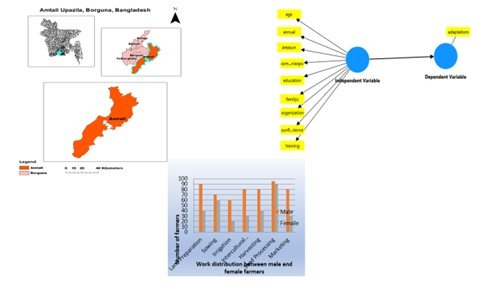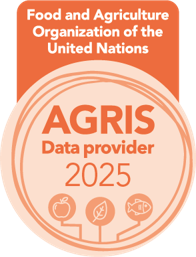Farmers’ adaptation strategies towards soil salinity effects in sunflower cultivation: A gender-based analysis of some selected south-central coastal areas in Bangladesh
Abstract
Rising salinity levels in the coastal regions of Bangladesh, driven by climate change, significantly affect agricultural productivity. Adaptation strategies to mitigate the effects of salinity are crucial for increasing crop production. This paper examines the adaptation strategies employed by male and female sunflower farmers in response to salinity intrusion in the south-central coastal zones of Bangladesh. We collected data through a household survey of 50 men and 50 women, supplemented by interviews and focus group discussions with farmers. The sample size was determined using a probabilistic sampling method. The questionnaire included open-ended and closed-ended questions and pretested with farmers before conducting final interview. Our results indicated that significant variables influencing adaptation strategies among male sunflower farmers included age, communication exposure, and training experience (p < 0.05). For female sunflower farmers, significant factors were age, communication exposure, training experience, and cultivated sunflower area (p < 0.01). Both regression models exhibited a satisfactory fit. Additionally, the primary adaptation strategies adopted by both male and female farmers included the application of fertilizers and pesticides. These findings provide valuable insights for policymakers in formulating future farm-level gender based adaptation strategies for cultivating sunflower.
Keywords:
Adaptation,, Bangladesh, Coastal area, Gender, Salinity, SunflowerDownloads
References
Ahmed, S., & Eklund, E. (2021). Climate change impacts in coastal Bangladesh: Migration, gender and environmental injustice. Asian Affairs, 52(1), 155-174. https://doi.org/10.1080/03068374.2021.1880213
Ahmed, Z., Shew, A. M., Mondal, M. K., Yadav, S., Jagadish, S. K., Prasad, P. V., & Bakuluzzaman, M. (2022). Climate risk perceptions and perceived yield loss increases agricultural technology adoption in the polder areas of Bangladesh. Journal of Rural Studies, 94, 274-286. https://doi.org/10.1016/j.jrurstud.2022.06.008
Aryal, J. P., Sapkota, T. B., Rahut, D. B., Krupnik, T. J., Shahrin, S., Jat, M. L., & Stirling, C. M. (2020). Major climate risks and adaptation strategies of smallholder farmers in coastal Bangladesh. Environmental Management, 66(1), 105-120. https://doi.org/10.1007/s00267-020-01291-8
Bhuyan, M. I., Mia, S., Supit, I., & Ludwig, F. (2023a). Spatio-temporal variability in soil and water salinity in the south-central coast of Bangladesh. Catena, 222, 106786. https://doi.org/10.1016/j.catena.2022.106786
Bhuyan, M. I., Supit, I., Kumar, U., Mia, S., & Ludwig, F. (2024). The significance of farmers’ climate change and salinity perceptions for on-farm adaptation strategies in the south-central coast of Bangladesh. Journal of Agriculture and Food Research, 16, 101097. https://doi.org/10.1016/j.jafr.2024.101097
Bhuyan, M. I., Supit, I., Mia, S., Mulder, M., & Ludwig, F. (2023b). Effect of soil and water salinity on dry season boro rice production in the south-central coastal area of Bangladesh. Heliyon, 9(8). 10.1016/j.heliyon.2023.e19180
Feinstein, N. W., & Mach, K. J. (2020). Three roles for education in climate change adaptation. Climate policy, 20(3), 317-322. https://doi.org/10.1080/14693062.2019.1701975
Hill, C., Dunn, F., Haque, A., Amoako-Johnson, F., Nicholls, R. J., Raju, P. V., & Appeaning Addo, K. (2020). Hotspots of present and future risk within deltas: Hazards, exposure and vulnerability. Deltas in the Anthropocene, 127-151. https://doi.org/10.1007/978-3-030-23517-8
Islam, M. A., Warwick, N., Koech, R., Amin, M. N., & de Bruyn, L. L. (2020). The importance of farmers' perceptions of salinity and adaptation strategies for ensuring food security: Evidence from the coastal rice growing areas of Bangladesh. Science of the Total Environment, 727, 138674. https://doi.org/10.1016/j.scitotenv.2020.138674
Islam, M. N., Bell, R. W., Barrett-Lennard, E. G., & Maniruzzaman, M. (2022). Shallow surface and subsurface drains alleviate waterlogging and salinity in a clay-textured soil and improve the yield of sunflower in the Ganges Delta. Agronomy for Sustainable Development, 42(2), 16. https://doi.org/10.1007/s13593-021-00746-4
Jalal, M. J. E., Khan, M. A., Hossain, M. E., Yedla, S., & Alam, G. M. (2021). Does climate change stimulate household vulnerability and income diversity? Evidence from southern coastal region of Bangladesh. Heliyon, 7(9). https://doi.org/10.1016/j.heliyon.2021.e07990
Kabir, A., Amin, M. N., Roy, K., & Hossain, M. S. (2021). Determinants of climate change adaptation strategies in the coastal zone of Bangladesh: implications for adaptation to climate change in developing countries. Mitigation and Adaptation Strategies for Global Change, 26(7), 30. https://doi.org/10.1007/s11027-021-09968-z
Kothari, C. R. (2004). Quantitative techniques. New Delhi: Vikas Publishing House Pvt, Ltd.
Khouni, M., Hammecker, C., Grunberger, O., & Chaabane, H. (2023). Effect of salinity on the fate of pesticides in irrigated systems: a first overview. Environmental Science and Pollution Research, 30(39), 90471-90488. https://doi.org/10.1007/s11356-023-28860-8
Kumar, U., Werners, S., Roy, S., Ashraf, S., Hoang, L. P., Kumar Datta, D., & Ludwig, F. (2020). Role of information in Farmers’ response to weather and water related stresses in the lower Bengal Delta, Bangladesh. Sustainability, 12(16), 6598. https://doi.org/10.3390/su12166598
Mazumder, M. S. U., & Kabir, M. H. (2022). Farmers’ adaptations strategies towards soil salinity effects in agriculture: the interior coast of Bangladesh. Climate Policy, 22(4), 464-479. https://doi.org/10.1080/14693062.2021.2024126
Medendorp, J. W., Reeves, N. P., Celi, V. G. S. Y. R., Harun-Ar-Rashid, M., Krupnik, T. J., Lutomia, A. N., ... & Bello-Bravo, J. (2022). Large-scale rollout of extension training in Bangladesh: Challenges and opportunities for gender-inclusive participation. Plos one, 17(7), e0270662. https://doi.org/10.1371/journal.pone.0270662
Nasim, M., Khatun, A., Kabir, M. J., Mostafizur, A. B. M., Mamun, M. A. A., Sarkar, M. A. R., & Kabir, M. S. (2021). Intensification of cropping through utilization of fallow period and unutilized land resources in Bangladesh. Bangladesh Rice Journal, 25(1), 89-100. https://org/10.3329/brj.v25i1.55181
Naz, F., & Saqib, S. E. (2021). Gender-based differences in flood vulnerability among men and women in the char farming households of Bangladesh. Natural Hazards, 106(1), 655-677. https://doi.org/10.1007/s11069-020-04482-y
Rogers, E. M. (1995). The Diffusion of Innovations, 4th Edition, Free Press, New York, NY.
Sarker, K. K., Mainuddin, M., Bell, R. W., Kamar, S. S. A., Akanda, M. A., Sarker, B. C., & Barrett-Lennard, E. G. (2024). Response of Sunflower Yield and Water Productivity to Saline Water Irrigation in the Coastal Zones of the Ganges Delta. Soil Systems, 8(1), 20. https://doi.org/10.3390/soilsystems8010020
Sloat, L. L., Davis, S. J., Gerber, J. S., Moore, F. C., Ray, D. K., West, P. C., & Mueller, N. D. (2020). Climate adaptation by crop migration. Nature communications, 11(1), 1243. https://doi.org/10.1038/s41467-020-15076-4

Published
How to Cite
Issue
Section
Copyright (c) 2024 Agriculture and Environmental Science Academy

This work is licensed under a Creative Commons Attribution-NonCommercial 4.0 International License.

